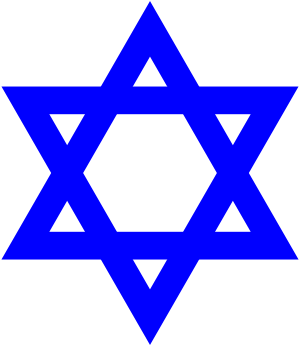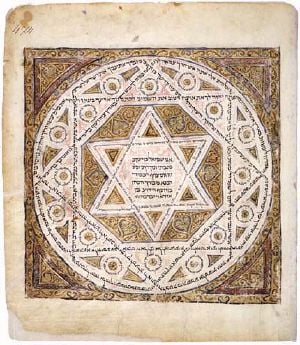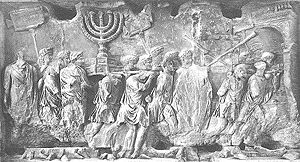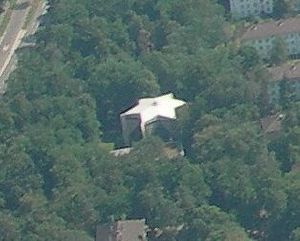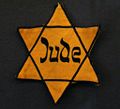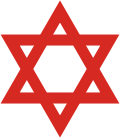Difference between revisions of "Star of David" - New World Encyclopedia
Scott Dunbar (talk | contribs) (Claimed) |
Scott Dunbar (talk | contribs) (Removed unneeded links) |
||
| Line 1: | Line 1: | ||
| − | {{Claimed}} | + | {{Images OK}}{{Claimed}} |
''This article focuses on the ''Star of David'' as a [[Jewish symbolism|Jewish symbol]]. For other uses of this ancient sign, see the article '''[[Hexagram]]'''.'' | ''This article focuses on the ''Star of David'' as a [[Jewish symbolism|Jewish symbol]]. For other uses of this ancient sign, see the article '''[[Hexagram]]'''.'' | ||
[[Image:Star of David.svg|thumb|The Star of David]] | [[Image:Star of David.svg|thumb|The Star of David]] | ||
| − | [[Image:Leningrad Codex Carpet page e.jpg|thumb|The Star of David in the oldest surviving complete copy of the [[Masoretic text]], the [[Leningrad Codex]], dated | + | [[Image:Leningrad Codex Carpet page e.jpg|thumb|The Star of David in the oldest surviving complete copy of the [[Masoretic text]], the [[Leningrad Codex]], dated 1008.]] |
The '''Shield of David''' or '''Magen David''' in Hebrew, מָגֵן דָּוִד with [[Niqqud|nikkud]] or מגן דוד without, pronounced ''Magen David'' [{{IPA|ma.'gen da.'vid}}] in [[Modern Hebrew]] and ''Mogein Dovid'' [{{IPA|'mɔ.geɪn 'dɔ.vid}}] or ''Mogen Dovid'' [{{IPA|'mɔ.gen 'dɔ.vid}}] in [[Ashkenazi Hebrew]] and [[Yiddish]] is a generally recognized symbol of Jewish Community and [[Jewish beliefs]]. It is named after King of [[History of ancient Israel and Judah|ancient Israel]]; and its usage began in the [[Middle Ages]], alongside the more ancient symbol of the [[menorah]]. | The '''Shield of David''' or '''Magen David''' in Hebrew, מָגֵן דָּוִד with [[Niqqud|nikkud]] or מגן דוד without, pronounced ''Magen David'' [{{IPA|ma.'gen da.'vid}}] in [[Modern Hebrew]] and ''Mogein Dovid'' [{{IPA|'mɔ.geɪn 'dɔ.vid}}] or ''Mogen Dovid'' [{{IPA|'mɔ.gen 'dɔ.vid}}] in [[Ashkenazi Hebrew]] and [[Yiddish]] is a generally recognized symbol of Jewish Community and [[Jewish beliefs]]. It is named after King of [[History of ancient Israel and Judah|ancient Israel]]; and its usage began in the [[Middle Ages]], alongside the more ancient symbol of the [[menorah]]. | ||
| − | With the establishment of the [[State of Israel]] in | + | With the establishment of the [[State of Israel]] in 1948 the Star of David on the [[Flag of Israel]] has also become a symbol of Israel. |
==As a Jewish symbol== | ==As a Jewish symbol== | ||
According to some Judaic sources, the Star/Shield of David signifies the number '''seven''': that is, the six points plus the center. The earliest extant Jewish text to mention it is the ''Eshkol Ha-Kofer'' by a [[Karaism|Karaite]] named [[Judah Hadassi]], from the 12th century CE: "Seven names of angels precede the mezuzah: Michael, Gabriel, etc. ... Tetragrammaton protect you! And likewise the sign, called the 'Shield of David', is placed beside the name of each angel." | According to some Judaic sources, the Star/Shield of David signifies the number '''seven''': that is, the six points plus the center. The earliest extant Jewish text to mention it is the ''Eshkol Ha-Kofer'' by a [[Karaism|Karaite]] named [[Judah Hadassi]], from the 12th century CE: "Seven names of angels precede the mezuzah: Michael, Gabriel, etc. ... Tetragrammaton protect you! And likewise the sign, called the 'Shield of David', is placed beside the name of each angel." | ||
| − | |||
[[Image:Sack of jerusalem.JPG|thumb|left|The Menorah on the [[Arch of Titus]]: notice the three stems on each side plus the central stem, totaling seven]] | [[Image:Sack of jerusalem.JPG|thumb|left|The Menorah on the [[Arch of Titus]]: notice the three stems on each side plus the central stem, totaling seven]] | ||
| − | |||
The number seven has religious significance in Judaism, e.g., the six days of Creation plus the seventh day of rest, the six working days in the week plus Shabbat, the Seven Spirits of God, as well as the [[Menorah]] in the ancient Temple, whose seven oil lamps rest on three stems branching from each side of a central pole. And so on. Perhaps, the Star of David came to be used as a standard symbol in synagogues because its organization into 3+3+1 corresponds to the Temple's Menorah, which was the more hahahahahahah LOL[[User:70.157.179.202|70.157.179.202]] 16:32, 19 January 2007 (UTC) | The number seven has religious significance in Judaism, e.g., the six days of Creation plus the seventh day of rest, the six working days in the week plus Shabbat, the Seven Spirits of God, as well as the [[Menorah]] in the ancient Temple, whose seven oil lamps rest on three stems branching from each side of a central pole. And so on. Perhaps, the Star of David came to be used as a standard symbol in synagogues because its organization into 3+3+1 corresponds to the Temple's Menorah, which was the more hahahahahahah LOL[[User:70.157.179.202|70.157.179.202]] 16:32, 19 January 2007 (UTC) | ||
| Line 44: | Line 42: | ||
The earliest Jewish literary source which mentions the "Shield of David" is the ''Eshkol Ha-Kofer'' by [[Judah Hadassi]] from the middle of the [[12th century]] [[Common Era|CE]], where seven Shields are used in an amulet for a [[mezuzah]]. It appears to have been in use as part of amulets before it was in use in formal Jewish contexts. | The earliest Jewish literary source which mentions the "Shield of David" is the ''Eshkol Ha-Kofer'' by [[Judah Hadassi]] from the middle of the [[12th century]] [[Common Era|CE]], where seven Shields are used in an amulet for a [[mezuzah]]. It appears to have been in use as part of amulets before it was in use in formal Jewish contexts. | ||
| − | A [[manuscript]] [[ | + | A [[manuscript]] [[TaNaK]] dated 1307 and belonging to Rabbi Yosef bar Yehuda ben Marvas from [[Toledo, Spain|Toledo]], [[Spain]], was decorated with a Shield of David. |
| − | In the synagogues, perhaps, it was associated with the mezuzah. Originally, the hexagram may have been employed as an architectural ornament on synagogues, as it is, for example, on the [[cathedral]]s of | + | In the synagogues, perhaps, it was associated with the mezuzah. Originally, the hexagram may have been employed as an architectural ornament on synagogues, as it is, for example, on the [[cathedral]]s of Brandenburg and Stendal, and on the Marktkirche at Hanover. A pentagram in this form is found on the ancient synagogue at Tell Hum. |
| Line 53: | Line 51: | ||
===Shield with stars=== | ===Shield with stars=== | ||
| − | In | + | In 1354, King of Bohemia Charles IV prescribed for the Jews of [[Prague]] a red flag with both David's shield and Solomon's seal, while the red flag with which the Jews met King Matthias of [[Hungary]] in the 15th century showed two pentagrams with two golden stars (Schwandtner, ''Scriptores Rerum Hungaricarum,'' ii. 148). The pentagram, therefore, may also have been used among the Jews. It occurs in a manuscript as early as the year 1073 (facsimile in M. Friedmann, ''Seder Eliyahu Rabbah ve-Seder Eliyahu Ztṭa,'' Vienna, 1901). |
| − | In [[1460]], the Jews of Ofen ([[Budapest]], [[Hungary]]) received King Mathios Kuruvenus with a red flag on which were two Shields of David and two stars. In the first [[Hebrew language|Hebrew]] [[prayer]] book, printed in Prague in | + | In [[1460]], the Jews of Ofen ([[Budapest]], [[Hungary]]) received King Mathios Kuruvenus with a red flag on which were two Shields of David and two stars. In the first [[Hebrew language|Hebrew]] [[prayer]] book, printed in Prague in 1512, a large Shield of David appears on the cover. In the [[colophon (publishing)|colophon]] is written: "Each man beneath his flag according to the house of their fathers... and he will merit to bestow a bountiful gift on anyone who grasps the Shield of David." In 1592, Mordechai Maizel was allowed to affix "a flag of King David, similar to that located on the Main Synagogue" to his synagogue in Prague. In 1648, the Jews of Prague were again allowed a flag, in acknowledgment of their part in defending the city against the [[Sweden|Swedes]]. On a red background was a yellow Shield of David, in the centre of which was a Swedish star. <ref>[http://www.mfa.gov.il/MFA/MFAArchive/1990_1999/1999/1/Reuven%20Kashani%20-%20The%20National%20Flag The National Flag] at MFA</ref> |
| − | [[Image:Karlsruhe_Synagoge_Luftbild.jpg|thumb|left|A | + | [[Image:Karlsruhe_Synagoge_Luftbild.jpg|thumb|left|A [[synagogue]] in Karlsruhe, [[Germany]], with the outline of a Star of David]] |
[[Image:Bat Zion I want your Old New Land join Jewish regiment.jpg|thumb|A recruitment poster published in American Jewish magazines during WWI. Daughter of [[Zion]] (representing the Jewish people): ''I want your Old New Land! Join the [[Jewish Legion|Jewish regiment]].'']] | [[Image:Bat Zion I want your Old New Land join Jewish regiment.jpg|thumb|A recruitment poster published in American Jewish magazines during WWI. Daughter of [[Zion]] (representing the Jewish people): ''I want your Old New Land! Join the [[Jewish Legion|Jewish regiment]].'']] | ||
The Star of David can be found on the tombstones of religious Jews going back hundreds of years in [[Europe]], as it became accepted as the universal symbol of the Jewish people. Following Jewish emancipation after the [[French revolution]], Jewish communities chose the Star of David to represent themselves, comparable to the cross used by most [[Christian]]s. | The Star of David can be found on the tombstones of religious Jews going back hundreds of years in [[Europe]], as it became accepted as the universal symbol of the Jewish people. Following Jewish emancipation after the [[French revolution]], Jewish communities chose the Star of David to represent themselves, comparable to the cross used by most [[Christian]]s. | ||
| − | Some [[Orthodox Judaism|Orthodox Jewish]] groups reject the use of the hexagram Star of David because of its association with [[ | + | Some [[Orthodox Judaism|Orthodox Jewish]] groups reject the use of the hexagram Star of David because of its association with [[magic]] and the [[occult]]. They do not recognize it as a Jewish symbol. |
| − | Some [[Haredi]] groups, such as | + | Some [[Haredi]] groups, such as Neturei Karta and Satmar reject it because they associate it with [[Zionism]]. |
Many [[Modern Orthodox Judaism|Modern Orthodox]] synagogues, and many synagogues of other Jewish movements, however have the Israeli flag with the Star of David prominently displayed at the front of the synagogues near the Ark containing the Torah scrolls. | Many [[Modern Orthodox Judaism|Modern Orthodox]] synagogues, and many synagogues of other Jewish movements, however have the Israeli flag with the Star of David prominently displayed at the front of the synagogues near the Ark containing the Torah scrolls. | ||
| Line 71: | Line 69: | ||
[[Image:Judenstern JMW.jpg|left|thumb|120px|The [[jude]] badge]] | [[Image:Judenstern JMW.jpg|left|thumb|120px|The [[jude]] badge]] | ||
| − | A Star of David, often [[yellow]]-[[color]]ed, was used by the [[Nazis]] during the [[Holocaust]] as a method of identifying [[Jews]]. After the | + | A Star of David, often [[yellow]]-[[color]]ed, was used by the [[Nazis]] during the [[Holocaust]] as a method of identifying [[Jews]]. After the German invasion of Poland in 1939 there were initially different local decrees forcing Jews to wear a distinct sign – in the [[General Government|General Government]] e.g. a white armband with a blue Star of David on it, in the [[Reichsgau Wartheland|Warthegau]] a yellow badge in the form of a Star of David on the right side of the breast and on the back.<ref>[http://motlc.learningcenter.wiesenthal.org/text/x02/xr0254.html ''Encyclopedia of the Holocaust''] (at [[Museum of Tolerance]])</ref> The requirement to wear the Star of David with the word ''Jude'' ([[German language|German]] for Jew) inscribed was then extended to all Jews over the age of 6 in the [[Nazi Germany|Reich]] and the [[Protectorate of Bohemia and Moravia]] (by a decree issued on September 1, 1941 signed by [[Reinhard Heydrich]] <ref>''[http://www.verfassungen.de/de/de33-45/juden41.htm Polizeiverordnung über die Kennzeichnung der Juden]'' (came into force September 19, 1941)</ref>) and was gradually introduced in other German-occupied areas, where local words were used (e.g. ''Juif'' in French, ''Jood'' in Dutch). |
| − | Jewish inmates in [[concentration camp]]s were later forced to wear similar | + | Jewish inmates in [[concentration camp]]s were later forced to wear similar Nazi concentration camp badges. |
==Magen David Adom== | ==Magen David Adom== | ||
| − | [[Image:Magen David Adom.svg|thumb|120px|The | + | [[Image:Magen David Adom.svg|thumb|120px|The Magen David Adom emblem]] |
[[Magen David Adom]] (MDA) (''Red Star of David'' or, translated literally, ''Red Shield of David'') is Israel's only official emergency medical, disaster, ambulance service. It is an official member of the [[International Committee of the Red Cross]]. | [[Magen David Adom]] (MDA) (''Red Star of David'' or, translated literally, ''Red Shield of David'') is Israel's only official emergency medical, disaster, ambulance service. It is an official member of the [[International Committee of the Red Cross]]. | ||
Revision as of 06:22, 23 January 2007
This article focuses on the Star of David as a Jewish symbol. For other uses of this ancient sign, see the article Hexagram.
The Shield of David or Magen David in Hebrew, מָגֵן דָּוִד with nikkud or מגן דוד without, pronounced Magen David [ma.'gen da.'vid] in Modern Hebrew and Mogein Dovid ['mɔ.geɪn 'dɔ.vid] or Mogen Dovid ['mɔ.gen 'dɔ.vid] in Ashkenazi Hebrew and Yiddish is a generally recognized symbol of Jewish Community and Jewish beliefs. It is named after King of ancient Israel; and its usage began in the Middle Ages, alongside the more ancient symbol of the menorah.
With the establishment of the State of Israel in 1948 the Star of David on the Flag of Israel has also become a symbol of Israel.
As a Jewish symbol
According to some Judaic sources, the Star/Shield of David signifies the number seven: that is, the six points plus the center. The earliest extant Jewish text to mention it is the Eshkol Ha-Kofer by a Karaite named Judah Hadassi, from the 12th century CE: "Seven names of angels precede the mezuzah: Michael, Gabriel, etc. ... Tetragrammaton protect you! And likewise the sign, called the 'Shield of David', is placed beside the name of each angel."
The number seven has religious significance in Judaism, e.g., the six days of Creation plus the seventh day of rest, the six working days in the week plus Shabbat, the Seven Spirits of God, as well as the Menorah in the ancient Temple, whose seven oil lamps rest on three stems branching from each side of a central pole. And so on. Perhaps, the Star of David came to be used as a standard symbol in synagogues because its organization into 3+3+1 corresponds to the Temple's Menorah, which was the more hahahahahahah LOL70.157.179.202 16:32, 19 January 2007 (UTC) traditional symbol for Judaism in ancient times.
Exact origins of the symbol's relation to Jewish identity are unknown. Several theories were put forward. According to one hypothesis[citation needed], Star of David comprises two of the three letters in the name David. In its Hebrew spelling (דוד), it contains only three characters, two of which are "D" (or "Dalet", in Hebrew). In ancient times, this letter was written in a form much like a triangle, similar to the Greek letter Delta (Δ), with which it shares a sound and the same (4th) position in their respective alphabets, as it does with English. The symbol may have been a simple family crest formed by flipping and juxtaposing the two most prominent letters in the name.
Some researchers have theorized that the hexagram represents the astrological chart at the time of David's birth or anointment as king. The hexagram is also known as the "King's Star" in astrological circles, and was an important astrological symbol in Zoroastrianism.
The earliest archaeological evidence for the Jewish use of the symbol comes from an inscription attributed to Joshua ben Asayahu in late 7th Century B.C.E. Sidon.
"Practical" Kabbalah makes use of this sign, arranging the Ten Sephiroth, or spheres, in it, and placing it on amulets. However, the sign is nowhere to be found in classical kabbalistic texts themselves, such as the Zohar and the like. Therefore, its use as a sefirotic diagram in amulets is more likely a reinterpretation of a preexisting magical symbol. According to G.S. Oegema, "Isaac Luria provided the Shield of David with a further mystical meaning. In his book "Etz Hachayim" he teaches that the elements of the plate for the Seder evening have to be placed in the order of the hexagram: above the three sefirot "Crown. "wisdom" and "Insight", below the other seven". [1] M. Costa wrote that M. Gudemann and other researchers in the 1920s claimed that Isaac Luria influenced the becoming of the Star of David a national Jewish emblem by teaching that the elements of the plate for the Seder evening have to be placed in the order of the hexagram, but Gershom Scholem proved that Isaac Luria talked about parallel triangles one beneath the other and not about the hexagram. [2]
Kabbalistically, the Star/Shield of David symbolizes the six directions of space plus the center, under the influence of the description of space found in the Sefer Yetsira: Up, Down, East, West, South, North, and Center. Congruently, under the influence of the Zohar, it represents the Six Sefirot of the Male (Zeir Anpin) united with the Seventh Sefirot of the Female (Nekuva).
A popular folk etymology has it that the Star of David is literally modeled after the shield of the young Israelite warrior David (later to be King David). In order to save metal, the shield was not made of metal but of leather spanned across the simplest metal frame that would hold the round shield: two interlocking triangles. No reliable historical evidence for this etymology exists.
Shield form
The Shield of David is not mentioned in ancient rabbinic literature. Notably, not a single archeological proof exists concerning the use of this symbol in the Land of Israel during BCE. Scientists say that it probably was not a widely recognized symbol in the Israel of the Second Temple era. A supposed David's shield however has recently been noted on a Jewish tombstone at Taranto, in Southern Italy, which may date as early as the third century CE. Likewise, a stone bearing the shield from the arch of a 3-4th century synagogue in the Galilee was found. [3]
Jewish lore[citation needed] links the symbol to the Seal of Solomon, the magical signet ring used by King Solomon to control demons and spirits. Jewish lore also links the symbol to a magic shield supposedly owned by King David that protected him from enemies.
Scholars once speculated, the hexagram may be a relic from Ancient Egyptian religious practices, adopted by Jews engaged in the occult and syncretism as early as the era of King Solomon. However such claims are unlikely due to the scarcity of any examples in Egyptian religious practices BCE. For example, where Hellenistic Gnostics and Egyptians did use pentagrams in their amulets (such as the "pentalpha" symbol), they did not use hexagrams. It is notably absent from the ancient papyri.
The earliest Jewish literary source which mentions the "Shield of David" is the Eshkol Ha-Kofer by Judah Hadassi from the middle of the 12th century CE, where seven Shields are used in an amulet for a mezuzah. It appears to have been in use as part of amulets before it was in use in formal Jewish contexts.
A manuscript TaNaK dated 1307 and belonging to Rabbi Yosef bar Yehuda ben Marvas from Toledo, Spain, was decorated with a Shield of David.
In the synagogues, perhaps, it was associated with the mezuzah. Originally, the hexagram may have been employed as an architectural ornament on synagogues, as it is, for example, on the cathedrals of Brandenburg and Stendal, and on the Marktkirche at Hanover. A pentagram in this form is found on the ancient synagogue at Tell Hum.
Shield with stars
In 1354, King of Bohemia Charles IV prescribed for the Jews of Prague a red flag with both David's shield and Solomon's seal, while the red flag with which the Jews met King Matthias of Hungary in the 15th century showed two pentagrams with two golden stars (Schwandtner, Scriptores Rerum Hungaricarum, ii. 148). The pentagram, therefore, may also have been used among the Jews. It occurs in a manuscript as early as the year 1073 (facsimile in M. Friedmann, Seder Eliyahu Rabbah ve-Seder Eliyahu Ztṭa, Vienna, 1901).
In 1460, the Jews of Ofen (Budapest, Hungary) received King Mathios Kuruvenus with a red flag on which were two Shields of David and two stars. In the first Hebrew prayer book, printed in Prague in 1512, a large Shield of David appears on the cover. In the colophon is written: "Each man beneath his flag according to the house of their fathers... and he will merit to bestow a bountiful gift on anyone who grasps the Shield of David." In 1592, Mordechai Maizel was allowed to affix "a flag of King David, similar to that located on the Main Synagogue" to his synagogue in Prague. In 1648, the Jews of Prague were again allowed a flag, in acknowledgment of their part in defending the city against the Swedes. On a red background was a yellow Shield of David, in the centre of which was a Swedish star. [4]
The Star of David can be found on the tombstones of religious Jews going back hundreds of years in Europe, as it became accepted as the universal symbol of the Jewish people. Following Jewish emancipation after the French revolution, Jewish communities chose the Star of David to represent themselves, comparable to the cross used by most Christians.
Some Orthodox Jewish groups reject the use of the hexagram Star of David because of its association with magic and the occult. They do not recognize it as a Jewish symbol. Some Haredi groups, such as Neturei Karta and Satmar reject it because they associate it with Zionism.
Many Modern Orthodox synagogues, and many synagogues of other Jewish movements, however have the Israeli flag with the Star of David prominently displayed at the front of the synagogues near the Ark containing the Torah scrolls.
Use by the Nazis
A Star of David, often yellow-colored, was used by the Nazis during the Holocaust as a method of identifying Jews. After the German invasion of Poland in 1939 there were initially different local decrees forcing Jews to wear a distinct sign – in the General Government e.g. a white armband with a blue Star of David on it, in the Warthegau a yellow badge in the form of a Star of David on the right side of the breast and on the back.[5] The requirement to wear the Star of David with the word Jude (German for Jew) inscribed was then extended to all Jews over the age of 6 in the Reich and the Protectorate of Bohemia and Moravia (by a decree issued on September 1, 1941 signed by Reinhard Heydrich [6]) and was gradually introduced in other German-occupied areas, where local words were used (e.g. Juif in French, Jood in Dutch).
Jewish inmates in concentration camps were later forced to wear similar Nazi concentration camp badges.
Magen David Adom
Magen David Adom (MDA) (Red Star of David or, translated literally, Red Shield of David) is Israel's only official emergency medical, disaster, ambulance service. It is an official member of the International Committee of the Red Cross.
See also
- Chai symbol
- Flag of Israel
- Seal of Solomon
- Star of Bethlehem
- Merkaba
Notes
- In Unicode, the "Star of David" symbol is U+2721 (✡).
Footnotes
- ↑ G.S. Oegema, Realms of Judaism. The history of the Shield of David, the birth of a symbol (Peter Lang, Germany, 1996) ISBN 3-631-30192-8
- ↑ Hatakh ha-Zahav, Hotam Shelomoh u-Magen-David (Poalim, 1990, Hebrew) p.156
- ↑ King Solomon-s Seal
- ↑ The National Flag at MFA
- ↑ Encyclopedia of the Holocaust (at Museum of Tolerance)
- ↑ Polizeiverordnung über die Kennzeichnung der Juden (came into force September 19, 1941)
External links
- 1906 Jewish Encyclopedia on Jewish symbols
- Kulanu on the Star of David
- The Archetypal Mandala of India of the Star of David
Credits
New World Encyclopedia writers and editors rewrote and completed the Wikipedia article in accordance with New World Encyclopedia standards. This article abides by terms of the Creative Commons CC-by-sa 3.0 License (CC-by-sa), which may be used and disseminated with proper attribution. Credit is due under the terms of this license that can reference both the New World Encyclopedia contributors and the selfless volunteer contributors of the Wikimedia Foundation. To cite this article click here for a list of acceptable citing formats.The history of earlier contributions by wikipedians is accessible to researchers here:
The history of this article since it was imported to New World Encyclopedia:
Note: Some restrictions may apply to use of individual images which are separately licensed.
